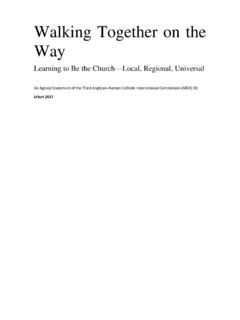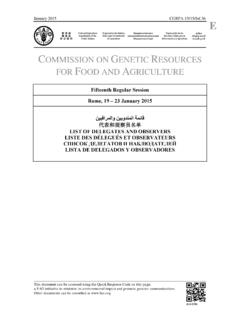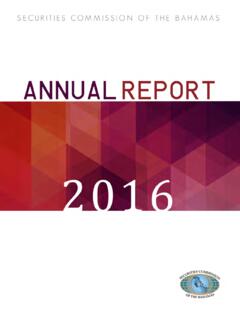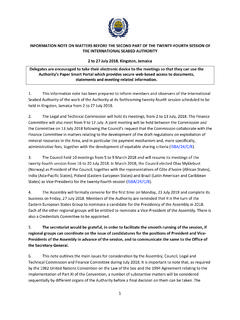Transcription of I U G L W L S . C R SUMMARY REPORT
1 IMPACTS ONUPPERGREATLAKESWATERLEVELS:ST. CLAIRRIVERFINALREPORT TO THEINTERNATIONALJOINTCOMMISSIONDECEMBER2 009 SUMMARYREPORTC atalogue number: E95-2/10-1-1-2009E-PDFISBN number:978-1-100-14159-6 REPORT CoverThe front cover shows two images of the St. Clair River prepared by the HydroSed2D model and Geographic InformationSystem rendering based on data collected by underwater multi-beam sonar surveys of the river bed in the summer of2008. The image to the right shows the channel morphology (depth and shape) from the mouth of the St. Clair Riverdownstream for about 10 kilometres ( miles). The yellow areas indicate shallower areas and there is a transition toblue, the deepest areas in the river. The image to the left illustrates typical velocities and flow directions in this first bendof the river. Green reflects higher velocities, while blue indicates lower velocities. The background image of the cover, taken from an underwater video survey conducted in the summer of 2008 at depths of 12 to 14 metres (39 to 46 feet) shows the mostly gravel material found on the river bed in the upper reach of the St.
2 Clair data collected from these types of surveys, and applying the best available models, scientists and engineers haveimproved our understanding of the hydraulics and morphology of the St. Clair River and, in turn, the effects on the river ofnatural forces and recent human cover graphic credit: Dr. Syed Moin, Study Co-ManagerStudy Logo: John Nevin, Communications AdvisorPhoto Credits:p. 2:Jill Wingfield, international Upper Great Lakes Studyp. 7:Rich Kelly, KCO Pic s & Stuff LLCp. 11:Elaine Sterrett Isely, Annis Water Resources Institute, Grand Valley State Universityp. 15: international Upper Great Lakes Studyp. 19: United States Geological Survey, Michigan Water Science Centerp. 20:Trilby MacDonald, international Upper Great Lakes StudyiIMPACTS ONUPPERGREATLAKESWATERLEVELS: ST. CLAIRRIVER SUMMARYREPORTIMPACTS ONUPPERGREATLAKESWATERLEVELS: ST. CLAIRRIVERI mpacts on Upper Great Lakes Water Levels: St. Clair Riveris the first of two major reports presenting the findings and recommendations of the bi-national international Upper Great Lakes Study (the Study).
3 The Studyis a five-year investigation launched by the international Joint Commission in 2007. The St. Clair River part of the Study was established to address widespread concerns among governments at all levels, property owners and other interests about the long term economic and environmental effects of low water levels in the upper Great Lakes. Scheduling of the St. Clair River part was accelerated by nearly one year to addressthese concerns on an urgent bi-national Study Board directed the work of nearly 100 scientists and engineers from governments, academia andthe private sector in both countries. The Study benefitted from a high level of independent peer review. The Study s Public Interest Advisory Group played a significant role in the Study s public information and engagement effort. A draft REPORT was made available for a 90-day public review and comment SUMMARY Reportprovides a synthesis of the Study s approach, findings and recommendations.
4 More infor-mation on the Study as well as the full scientific REPORT and its 34 scientific/technical reports are available at the Study swebsite: Study Board concluded that:1. The difference in water levels between Lake Michigan-Huron and Lake Erie has declined by about 23 centimetres (cm) (9 inches) between 1963 (following the last major navigational channel dredging in the St. Clair River) and 2006. 2. Three key factors contributed to this 23 cm (9 inches)change: A change in the conveyance(water-carrying capacity) of the St. Clair River accounts for an estimated 7 to 14 cm ( to inches) of the decline. Glacial isostatic adjustment(the uneven shifts of the earth s crust since the last period of continentalglaciations ended) accounts for about 4 to 5 cm ( to inches) of the fall. Changes in climatic patternsaccount for 9 to 17 cm ( to inches); this factor has become even more important in recent years, accounting for an estimated 58 to 76 percent of the decline between1996 and the total decline is not as simple as adding up the estimates of the three contributing factors.
5 These estimates are highly dependent on the choice of the specific time period being analyzed within the 1963-2006 ONUPPERGREATLAKESWATERLEVELS: ST. CLAIRRIVER SUMMARYREPORTiiFORMOREINFORMATIONFor more information on the international Upper Great Lakes Study, or to view the Study s 34 scientific/technical reports,please visit the Study s website: can also be obtained by writing to either of the following addresses: international Joint CommissionInternational Joint Commission234 Laurier Ave. W. 2401 Pennsylvania Avenue, NW22nd FloorFourth FloorOttawa, ON Washington, DCCanada K1P 6K6 USA 204403. There has been no significant erosion of the channel along the length of the St. Clair River bed since at least 2000. Based on survey data collected in 1971, there appears to have been some enlargement of thechannel between 1971 and 2000. However, the changes in the channel are within the error of the addition, there are issues regarding the reliability of the 1971 the basis of these findings and in accordance with its mandate, the Study Board recommends that: Remedial measures (to address past damages or adverse effects) not be undertaken in the St.
6 Clair River at this time. The need for mitigative measures (to address possible future changes that might result in adverse effects) in theSt. Clair River be examined as part of the comprehensive assessment of the future effects of climate change onwater supplies in the upper Great Lakes basin in REPORT 2 of the Study, on Lake Superior regulation, to be completed in Study Board also developed a set of recommendations addressing specific challenges in data collection,modelling and data management and coordination. Implementation of these measures by governments willbe an important part of the legacy of the Study, helping provide water resource managers and policy makerswith the information they need to regulate the upper Great Lakes more effectively under a changing climateregime and for adaptive management THEEVER-CHANGINGGREATLAKES: OF IN THEUPPERGREATLAKES: WHATHAV EWELEARNED? ..13 THEST. ITTOGETHER: WHATDID THESTUDYFIND?
7 IN THEUPPERGREATLAKES: THESTUDY LEGACY : WHEREDOWEGOFROMHERE? ..20iiiIMPACTS ONUPPERGREATLAKESWATERLEVELS: ST. CLAIRRIVER SUMMARYREPORT1 IMPACTS ONUPPERGREATLAKESWATERLEVELS: ST. CLAIRRIVER SUMMARYREPORTF igure 1 international Upper Great Lakes BasinFrom any perspective economic, social or environ-mental the Great Lakes are of tremendous importanceto Canada and the United States. The Great Lakes region is home to millions of people whodepend on the lakes as the largest single source of surfacefreshwater in the Western Hemisphere. The Great Lakessupport rich ecosystems and diverse animal and plantspecies and are the foundation of major industries such asmanufacturing, shipping, tourism, power generation andcommercial fishing. Many Native American communitiesand First Nations rely on the natural resources providedby the Great Lakes to meet their economic, cultural,medicinal and spiritual upper Great Lakes basin stretches from the headwatersof Lake Superior all the way downstream to Niagara Falls,an area of about 686,000 square kilometres (265,000square miles) (Figure 1).
8 The upper Great Lakes systemencompasses Superior, Michigan, Huron (including 1. THEEVER-CHANGINGGREATLAKES2 IMPACTS ONUPPERGREATLAKESWATERLEVELS: ST. CLAIRRIVER SUMMARYREPORTG eorgian Bay) and Erie, and the connecting channels ofthe St. Marys River, the Straits of Mackinac, the St. ClairRiver system (consisting of the St. Clair River, Lake St. Clair and the Detroit River), and the Niagara River.(For study purposes, Lake Michigan and Lake Huron areconsidered a single lake, because they have the same surfacewater elevation due to their shared connection at the broadand deep Straits of Mackinac.)Fluctuating lake levels are evidence of the continualchanges underway in the Great features of the Great Lakes the lake and river beds, water supplies and outflows are continually changing. Changes occur over a period of days, decadesand millennia. Sometimes the changes are subtle, othertimes profound. Fluctuating lake levels are dramatic evidence of suchchanges.
9 In general, Great Lakes water levels depend onthe storage capacity of the lakes, the outflow characteristicsof the connecting channels, and the water supply receivedby each lake. Water enters a lake by way of precipitation,runoff from its drainage basin, diversions in, and inflowfrom the lake or river upstream. Water leaves a lakethrough evaporation, diversions out and outlets to thedownstream lake. All of these processes vary over for water level measurements on the Great Lakes areavailable only since about 1860, though there are questionsabout the reliability and comparability of some older data,given the various types of measurement used over the precise patterns in fluctuating water levels are evidentin the data records of the past century. As shown in Figure 2, there were record low water levels during the late1920s and 1930s and again in the mid-1960s. Recordhigh levels were seen in the early 1950s, in 1973, and againin 1985-1986.
10 In the late 1990s, a nearly 30-year periodof above-average water level conditions in the upper GreatLakes ended. Over the last 10 years, Lake Michigan-Huron and Lake Superior have experienced lower thanaverage lake level conditions, with Lake Superior estab-lishing record lows in August and September of 2007. Water levels can also reverse quickly. For example, lakelevels dropped from very high to very low levels in a mat-ter of about two years from 1986 to 1988 and again from1997 to 1998. Even within the last year, there has been asignificant recovery of water levels on Lake Michigan-Huron and Lake Superior, though they remain below long-term lake water levels are of concern to many interests throughout the upper Great Lakes ONUPPERGREATLAKESWATERLEVELS: ST. CLAIRRIVER SUMMARYREPORT3 Figure 2 Upper Great Lakes Water Levels, 1918-2008 Note: Water surface elevations at are at Chart Datum on IGLD (1985); the black dots represent annual mean ONUPPERGREATLAKESWATERLEVELS: ST.



